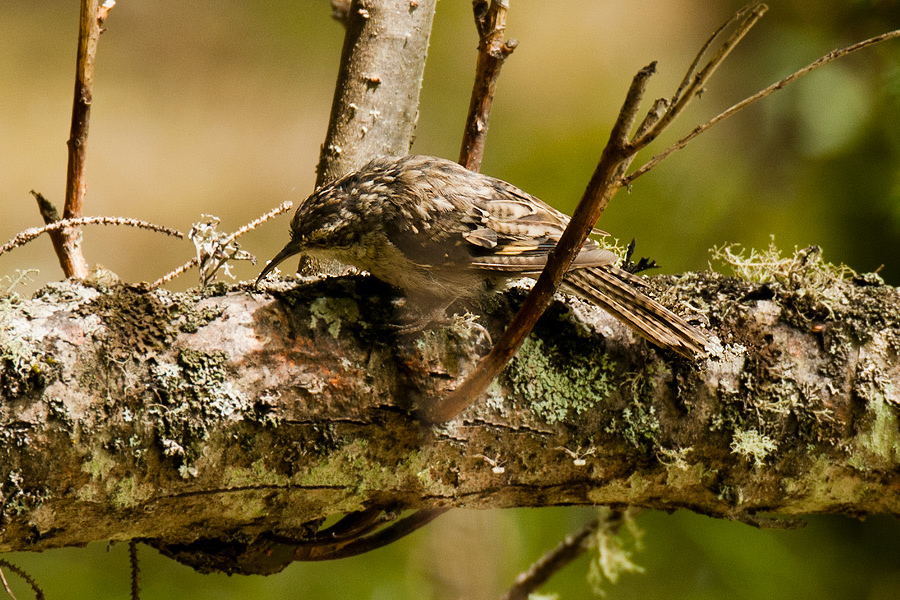
Bar-tailed Treecreeper Certhia himalayana is a hardy, high-altitude treecreeper with a distinct barred tail. Ranges disjointly from Pakistan and Uzbekistan through China and India to Burma. In China, yunnanensis from southern Shaanxi (Qin Mountains) and southwest Gansu (Min Mountains) south through western Sichuan to southeast Tibet and western Yunnan; disjunct population in southwest Guizhou. HABITAT & BEHAVIOR Mainly coniferous forests, in summer to 3600 m (11,810 ft.), winter to 1100 m (3,610 ft.). In typical treecreeper fashion, spirals jerkily up trunks of large trees, using strong tail as a prop, like a woodpecker; but is largely unable to move down the trunk. Having reached the top of a tree, it flies to the base of the next tree and creeps upward again. Also moves horizontally across boughs and on underside of branches. Eats invertebrates gleaned from bark. ID & COMPARISON Like all treecreepers, cryptic pigmentation renders it inconspicuous. Upperparts blackish-brown with sparse, white streaking on crown. Nape, mantle, and back have buff mottling. Wing pattern complex, with several blackish and buff bands; wing coverts (including alula) have whitish tips (most prominent and wedge-shaped on greater coverts; buff basal area on secondaries joins stair-like, warm buff markings on primaries; these are separated by blackish (on closed wing), arrow-shaped band from another, less distinct, warm buff and stair-like band that runs closer to the tips of flight feathers; whitish tips of flight feathers demarcated by irregular blackish band just inside; tertials barred with pale tips; primary bases also barred. Tail brown with clearly visible black bars, unique among treecreepers; brown rump also differentiates from other treecreepers in China, which have rufous-orange rumps. Blackish-brown band from bill through eye extends on cheeks, the latter with white mottling. Supercilium creamy white, faint in front of eye, broad and long behind. White throat fades into buffish-grey on breast (which may show indistinct dark scaling on sides); vent and undertail coverts grey. Newly fledged juvenile has shorter bill, blacker base color above and more rufous tone in buff markings, and prominent scaling on breast, but soon acquires plumage of adults. Hodgson’s Treecreeper C. hodgsoni and Eurasian Treecreeper C. familiaris occur at similar altitudes and in similar habitat but have a whiter and, hence, more distinct supercilium and a shorter bill. Sichuan Treecreeper C. tianquanensis and Rusty-flanked Treecreeper C. nipalensis usually occur at lower altitudes; Sichuan Treecreeper has a shorter, straighter bill, slightly browner underparts, and a unique descending trill, and Rusty-flanked Treecreeper has rufous flanks. Hume’s Treecreeper C. manipurensis and Sikkim Treecreeper C. discolor have darker throat and breast, and both have unbarred tails, tertials, and primary bases. All Chinese treecreepers except Bar-tailed have unbarred tail, primary bases, and tertials. BARE PARTS Fairly long and decurved bill black above, pale brown below. Pale brown feet large with long decurved claws (especially hind claw). VOICE Sweet, whistled, warbling song on same pitch, lasting 2–3 seconds. Call a thin tseee. — Craig Brelsford
THE TREECREEPERS OF CHINA
shanghaibirding.com has research on all seven species of treecreeper in China. Click any link:
Eurasian Treecreeper Certhia familiaris
Hodgson’s Treecreeper C. hodgsoni
Bar-tailed Treecreeper C. himalayana
Rusty-flanked Treecreeper C. nipalensis
Sikkim Treecreeper C. discolor
Hume’s Treecreeper C. manipurensis
Sichuan Treecreeper C. tianquanensis
ACKNOWLEDGEMENTS
Daniel Bengtsson served as chief ornithological consultant for Craig Brelsford’s Photographic Field Guide to the Birds of China, from which this species description is drawn.
